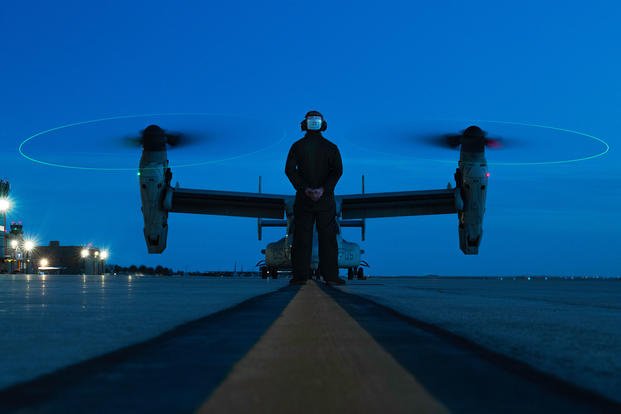The opinions expressed in this op-ed are those of the author and do not necessarily reflect the views of Military.com. If you would like to submit your own commentary, please send your article to [email protected] for consideration.
The crash of a CV-22 Osprey, call sign Gundam 22, off the coast of Japan in November 2023 has generated a wave of unfair scrutiny against the aircraft. The loss of any service member is an absolute tragedy, but the conversation surrounding the V-22 Osprey has become disproportionately negative, often overlooking key facts about the incident and the essential role this aircraft plays in our military’s success.
Critics paint a picture of the Osprey as an inherently dangerous aircraft, claiming it is more prone to accidents than other military platforms; however, the data and the facts tell a much different story.
The Marine Corps variant of the Osprey, the MV-22, has become a cornerstone of U.S. military operations, consistently proving its reliability in challenging environments. Despite its extensive use, the MV-22’s mishap rate per 100,000 flight hours is “equal to or less than any airframe flown,” according to the commandant of the Marine Corps, Gen. Eric M. Smith. He also recently said, “They’re completely safe. They have a better safety record than most aircraft.”
When compared to conventional helicopters, like the H-60 Black Hawk or the H-47 Chinook, the V-22’s safety record remains well within acceptable industry standards. Beyond its favorable safety record, the Osprey offers significant advantages and capabilities that conventional helicopters cannot match. Its unique tilt-rotor design enables it to take off and land in confined spaces while flying faster and farther than traditional helicopters. These advantages provide critical support in combat, medical evacuation operations, and disaster relief efforts, often meaning the difference between life and death.
The safety of our service members is and always will remain our highest priority. Use of the V-22 aircraft in a variety of critical environments is vital for the success of our men and women in uniform. At every stage of the V-22’s lifecycle, from development to combat operations, highly skilled professionals work diligently to ensure the aircraft’s safety and effectiveness. During my time in the Navy, and now as a member of the House Armed Services Committee, I have spent considerable time flying onboard the V-22; therefore, I know firsthand that this is not just a phenomenal aircraft, but it provides our military with unique capabilities and advantages that we simply cannot afford to be without.
The V-22 operates under stringent protocols and maintenance requirements, reinforcing the confidence military leaders have in the aircraft and its critical role in maintaining readiness and deterrence. While military flight operations are inherently risky, the Osprey remains an indispensable asset in our defense strategy.
We must remember and honor the eight airmen who tragically lost their lives in the mishap of Gundam 22, but we must also avoid any overreaction that would degrade our military’s operational capabilities moving forward. The Department of Defense conducted a thorough investigation into the incident, and we are working collaboratively to address the findings while taking the necessary steps to ensure the Osprey continues to operate safely and effectively.
It is the duty of Congress to rely on facts, not fears, when evaluating the V-22 Osprey. This aircraft is a combat-proven asset that deserves our continued support and investment. As we move forward, we will continue to improve and build upon the innovative technology embodied by the V-22, because ultimately, enhancing the capabilities of the V-22 will contribute to a more secure future for our country and ensure our military has the advantages it needs to compete with and win against our adversaries.
— Dr. Ronny Jackson has served as the U.S. representative for Texas’ 13th Congressional District since 2021 and currently serves on the House Agriculture Committee, the House Permanent Select Committee on Intelligence, the House Armed Services Committee, the House Foreign Affairs Committee and the House Select Subcommittee on the Coronavirus Pandemic. In 2019, after 25 years of service to his country, he retired from the U.S. Navy.
Story Continues
Read the full article here

